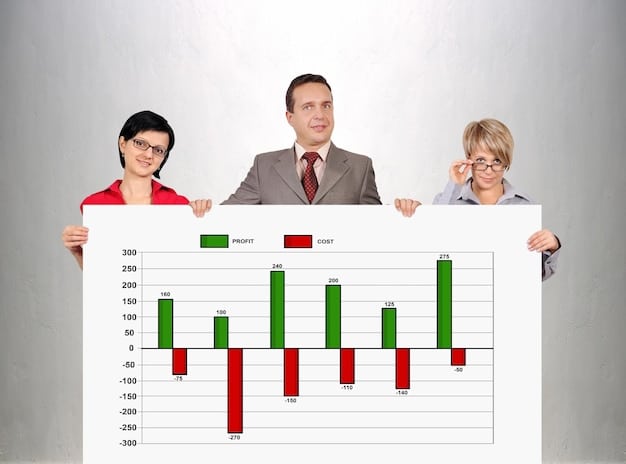Inverse ETFs: Profit from Market Correction in Next Quarter

Inverse ETFs are designed to increase in value when the market declines, offering investors a way to potentially profit from a predicted 10% market correction in the next quarter by effectively shorting the market without directly selling assets.
Navigating market volatility can be daunting, but Understanding Inverse ETFs: How to Profit from a Potential 10% Market Correction in the Next Quarter can provide an effective strategy. These financial instruments are designed to move in the opposite direction of a specific market index or benchmark, offering investors a unique opportunity to potentially profit during market downturns.
What are Inverse ETFs?
Inverse Exchange Traded Funds (ETFs) are financial tools that allow investors to profit from market declines. They are designed to provide returns that are the inverse of a particular market index or sector. In essence, they function as a way to short the market or hedge against potential losses in a portfolio without directly selling assets.
How Inverse ETFs Work
Inverse ETFs use various financial instruments, such as derivatives like futures contracts and swaps, to achieve their inverse correlation. When the underlying index goes down, the inverse ETF goes up, and vice versa. This inverse relationship is typically on a 1:1 basis, but leveraged inverse ETFs can amplify the returns.
Key Features of Inverse ETFs
One of the primary benefits of inverse ETFs is their simplicity. They trade on exchanges just like regular ETFs, making them accessible to most investors. Additionally, they offer a cost-effective way to implement a shorting strategy, as they eliminate the need to borrow securities or deal with margin requirements.
- Inverse ETFs aim to mirror the inverse performance of an index or benchmark.
- They use derivatives to achieve their investment goals.
- Inverse ETFs offer liquidity, trading like standard ETFs.
- They can be used for hedging or speculative purposes.
Inverse ETFs can be particularly useful in volatile markets or when an investor anticipates a short-term decline. However, they are not without risks, which we will explore in the next sections.

The Benefits and Risks of Investing in Inverse ETFs
Investing in inverse ETFs presents unique benefits and risks that investors must understand. While they can offer a way to profit from market declines, they also come with potential downsides that could impact investment returns.
Potential Benefits
One of the key benefits of inverse ETFs is their ability to hedge against portfolio losses. If an investor believes a particular sector or the overall market is overvalued, they can use inverse ETFs to offset potential declines. Furthermore, inverse ETFs can be used for speculative purposes, allowing investors to profit directly from market downturns.
Risks and Considerations
Inverse ETFs are not designed for long-term investment. Due to daily rebalancing and compounding, they can suffer from performance erosion over time, especially in volatile markets. Additionally, the use of derivatives can introduce counterparty risk and other complexities. Investors should also be aware of the potential for tracking errors, where the ETF’s performance deviates from its intended inverse relationship.
- Inverse ETFs are best suited for short-term strategies.
- Daily rebalancing can lead to performance erosion.
- The use of derivatives introduces additional risks.
- Tracking errors can impact returns.
Ultimately, the decision to invest in inverse ETFs should be based on a thorough understanding of their mechanics and a clear investment strategy. It’s essential to continuously monitor these investments and be prepared to adjust positions as market conditions change.
Identifying a Potential 10% Market Correction
Predicting a market correction is challenging, but understanding the economic indicators and market signals can help investors anticipate potential downturns. Identifying these signals early can allow for proactive strategies using inverse ETFs.
Economic Indicators
Economic indicators such as inflation rates, unemployment figures, and GDP growth can provide insights into the overall health of the economy. Rising inflation or slowing growth, for example, may signal a potential market correction. Keep an eye on these indicators.
Market Signals
Market signals, including rising price-to-earnings (P/E) ratios, increased market volatility, and declining investor sentiment, can also indicate a correction. These signals reflect a growing disconnect between market valuations and underlying fundamentals.

By monitoring both economic indicators and market signals, investors can better assess the likelihood of a market correction and make informed decisions about using inverse ETFs. However, it’s crucial to remember that these are just indicators, not guarantees, and market predictions should be treated with caution.
Strategies for Profiting from a Correction Using Inverse ETFs
Inverse ETFs can be a valuable tool for profiting from a market correction, but a strategic approach is essential. Timing and risk management are key to maximizing potential gains and minimizing losses.
Tactical Approaches
One approach is to use inverse ETFs as a hedge against a broader portfolio. If an investor anticipates a market decline, they can allocate a portion of their assets to inverse ETFs to offset potential losses in their long positions. Another strategy is to use inverse ETFs for short-term trades, capitalizing on rapid market movements.
Risk Management
Risk management is paramount when using inverse ETFs. Investors should set clear stop-loss orders to limit potential losses. It’s also important to avoid over-allocation, as inverse ETFs can be highly volatile. Diversifying investment strategies and not relying solely on inverse ETFs is also crucial.
- Hedge against long positions with inverse ETFs.
- Use stop-loss orders to limit downside risk.
- Avoid over-allocation to inverse ETFs.
- Monitor market conditions and adjust positions accordingly.
With careful planning and execution, inverse ETFs can be a powerful tool for navigating market corrections and potentially generating profits. However, they require active management and a disciplined approach to risk.
Examples of Inverse ETFs and Their Performance
Several inverse ETFs are available, each designed to track different market indexes or sectors. Understanding their performance can help investors make informed decisions about which ETFs to use.
Popular Inverse ETFs
Some popular inverse ETFs include the ProShares Short S&P 500 (SH), which aims to deliver the inverse of the daily performance of the S&P 500 index. Another example is the ProShares Short QQQ (PSQ), which tracks the inverse of the NASDAQ-100 index. These ETFs offer exposure to broad market movements and can be used for hedging or speculative purposes.
Analyzing Performance
When evaluating inverse ETFs, it’s important to consider their historical performance, expense ratios, and tracking accuracy. Investors should also be aware of any potential deviations from the intended inverse relationship. Analyzing these factors can help identify ETFs that are best suited for a particular investment strategy.
- ProShares Short S&P 500 (SH): Inverse of the S&P 500.
- ProShares Short QQQ (PSQ): Inverse of the NASDAQ-100.
- Evaluate historical performance and expense ratios.
- Consider tracking accuracy and potential deviations.
By studying different inverse ETFs and their performance, investors can gain a better understanding of how these instruments behave in various market conditions. This knowledge can be invaluable when developing a strategy to profit from a market correction.
Advanced Strategies with Leveraged Inverse ETFs
Leveraged inverse ETFs offer the potential for amplified returns, but they also come with increased risk. These ETFs use leverage to magnify the inverse performance of their underlying indexes, making them suitable for sophisticated investors.
Understanding Leverage
Leveraged inverse ETFs aim to deliver a multiple of the inverse daily performance of a specific index. For example, a 2x leveraged inverse ETF would seek to provide twice the inverse return of the index. While this can lead to significant gains in a short period, it also amplifies potential losses.
Strategic Uses
Leveraged inverse ETFs are typically used for very short-term tactical trades. Due to the effects of compounding and daily rebalancing, they are not suitable for long-term investment. Investors who use these ETFs should have a clear understanding of their mechanics and a well-defined exit strategy.
- Leveraged inverse ETFs amplify returns and risks.
- They are designed for short-term tactical trades.
- Compounding and rebalancing can impact long-term performance.
- Advanced knowledge and risk management are essential.
Leveraged inverse ETFs can be a powerful tool for experienced traders who seek to capitalize on short-term market movements. However, they should be approached with caution and a thorough understanding of their potential risks.
| Key Concept | Brief Description |
|---|---|
| 📉 Inverse ETFs | Profit when market indexes decline. |
| ⚠️ Risks | Not for long-term; daily rebalancing erodes value. |
| 📈 Leverage | Amplifies both potential returns and losses. |
| 🚦 Strategies | Use for hedging or short-term speculation only. |
FAQ
▼
An inverse ETF is a type of exchange-traded fund designed to profit from the decline in the value of an underlying benchmark or index, providing a way to short the market.
▼
These ETFs use derivatives like futures and swaps to achieve returns that mirror the inverse performance of a specific index or sector, effectively letting investors bet against the market.
▼
No, inverse ETFs are generally not suitable for long-term investing due to the effects of daily rebalancing and compounding, which can lead to performance erosion over time.
▼
The main risks include daily rebalancing erosion, potential tracking errors, and the complexities associated with derivatives, making them more volatile than traditional ETFs.
▼
Inverse ETFs can be used for hedging against potential losses in a portfolio or for short-term speculative trades when you anticipate a market downturn, requiring active management.
Conclusion
Understanding Inverse ETFs: How to Profit from a Potential 10% Market Correction in the Next Quarter offers a strategic opportunity for investors to navigate market downturns. Although these instruments come with inherent risks, they, when used with caution and strategic planning, can potentially yield considerable profit during corrections. By monitoring market signals and maintaining a disciplined approach, investors can leverage inverse ETFs effectively.





